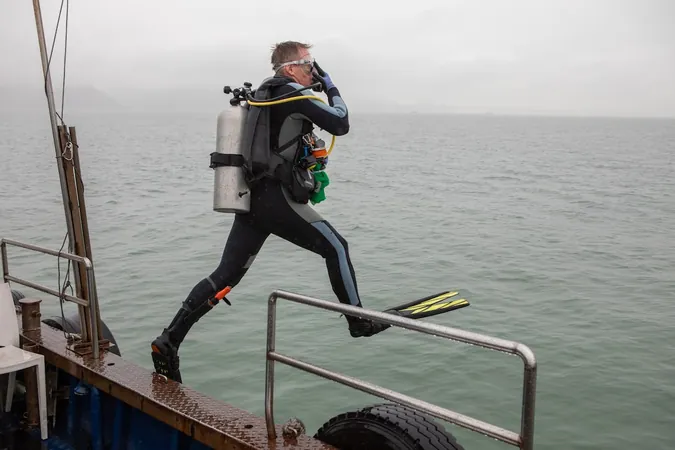
Reviving Hong Kong’s Forgotten Oysters: A Deep Dive into Conservation Efforts
2024-12-31
Author: Ling
Introduction
In a scene reminiscent of an adventurous sea expedition, conservationists are working tirelessly to restore a vital marine habitat in Hong Kong: the oyster. On a drizzly November day, Bayden Russell and his team from Hong Kong University, in collaboration with the global nonprofit The Nature Conservancy, were on an unusual mission between the busy runways of Hong Kong International Airport. Instead of reeling in fish, they were inspecting an artificial oyster reef that is becoming an oasis for marine life.
Historical Context
Once a staple of the local economy and cuisine, oysters have practically vanished from Hong Kong’s waters. Documented as far back as the ninth century, oysters were historically abundant in this region, providing sustenance and even building materials to early settlers. However, the rise of the lime industry in the 19th century, driven by intense demand for construction materials, led to the depletion of these bivalves. Marine Thomas, associate director of conservation at The Nature Conservancy Hong Kong, highlighted that the vast network of lime kilns established during British colonial times forever altered the local ecosystem.
Current Status of Oyster Reefs
Currently, oyster reefs are identified as one of the most endangered marine habitats globally, with an alarming 85 percent already lost. In Hong Kong, this decline has been compounded by pollution, extensive land reclamation, and the intense activity of one of the world’s busiest container ports. This dangerous combination has led to a dramatic drop in both wild oyster populations and commercial oyster farming, with only a few operations surviving in Deep Bay, directly across from Shenzhen.
Ecological Importance of Oysters
But the implications of this decline are significant. Oyster reefs function as crucial ecosystems, offering shelter and protection to a diverse range of marine species – including tiny crabs, fish, and mollusks. They play a vital role in maintaining water quality by filtering pollutants, making them a pivotal part of Hong Kong's rich marine biodiversity, which boasts nearly 6,000 species.
Local Oyster Subspecies
The local oyster subspecies, known as *Crassostrea hongkongensis*, stands out for its impressive filtration rate, especially in summer. Reestablishing these reefs could not only revive oyster populations but also bolster the overall health of marine ecosystems, aiding in habitat protection against storm surges and enhancing water quality.
Challenges in Conservation Efforts
The unique geographical and logistical challenges of reintroducing oysters cannot be overlooked. Hong Kong International Airport sits atop reclaimed land that was once a thriving oyster habitat, a historical irony not lost on the conservationists. They recognize that creating an oyster reef in this restricted area could render it the most protected reef in Hong Kong, if not the only one that enjoys such security.
Collaborative Restoration Efforts
Since 2021, the collaborative efforts of The Nature Conservancy and Hong Kong University have focused on building a new reef along a seawall near the airport's third runway. Using recycled materials like concrete rubble and shells salvaged from local restaurants, the team is committed to reversing the damage caused by historical practices.
Initial Signs of Success
During their detailed inspection of the newly formed reef, the team encountered challenges ranging from navigation issues—using only land markers due to airport regulations—to the physical task of diving in murky waters. Their efforts paid off as they spotted juvenile oysters clinging to old shells, hinting at the reef's potential for regeneration.
Future Prospects
Despite the initial encouraging signs, Professor Russell acknowledged the journey ahead. Full assessment of the reef’s condition and success will take years, emphasizing the ongoing commitment necessary for marine conservation. As Thomas aptly put it, “Conservation isn’t easy. It’s hard, hard work.”
Conclusion
In essence, this endeavor embodies a larger narrative about environmental renewal and the resilience of nature in the face of human impact. As conservationists strive to rebuild these valuable ecosystems, they are not only helping to restore the lost heritage of Hong Kong but also fostering a future where both marine life and humanity can thrive harmoniously. The journey may be arduous, but the stakes have never been higher.


 Brasil (PT)
Brasil (PT)
 Canada (EN)
Canada (EN)
 Chile (ES)
Chile (ES)
 Česko (CS)
Česko (CS)
 대한민국 (KO)
대한민국 (KO)
 España (ES)
España (ES)
 France (FR)
France (FR)
 Hong Kong (EN)
Hong Kong (EN)
 Italia (IT)
Italia (IT)
 日本 (JA)
日本 (JA)
 Magyarország (HU)
Magyarország (HU)
 Norge (NO)
Norge (NO)
 Polska (PL)
Polska (PL)
 Schweiz (DE)
Schweiz (DE)
 Singapore (EN)
Singapore (EN)
 Sverige (SV)
Sverige (SV)
 Suomi (FI)
Suomi (FI)
 Türkiye (TR)
Türkiye (TR)
 الإمارات العربية المتحدة (AR)
الإمارات العربية المتحدة (AR)